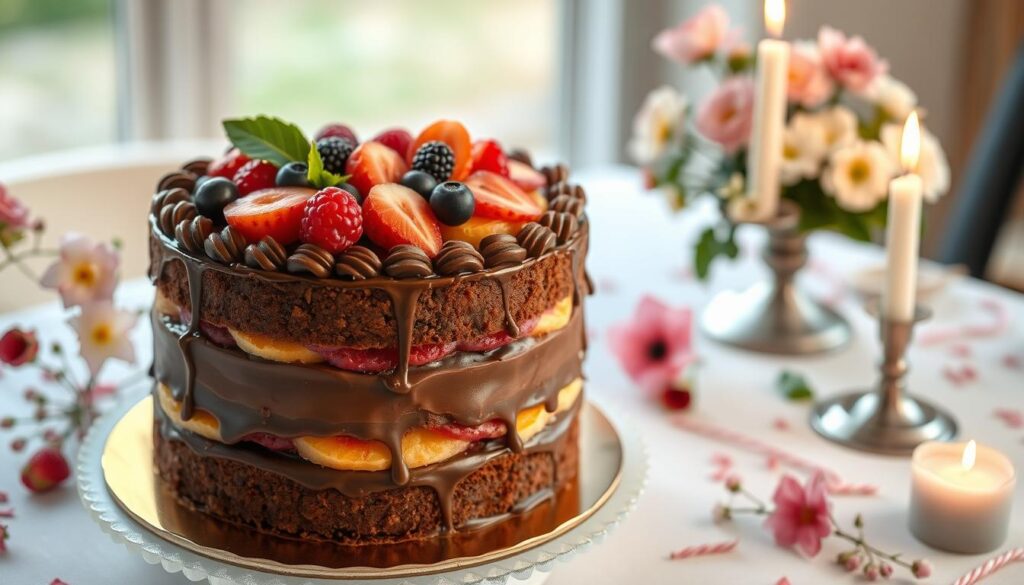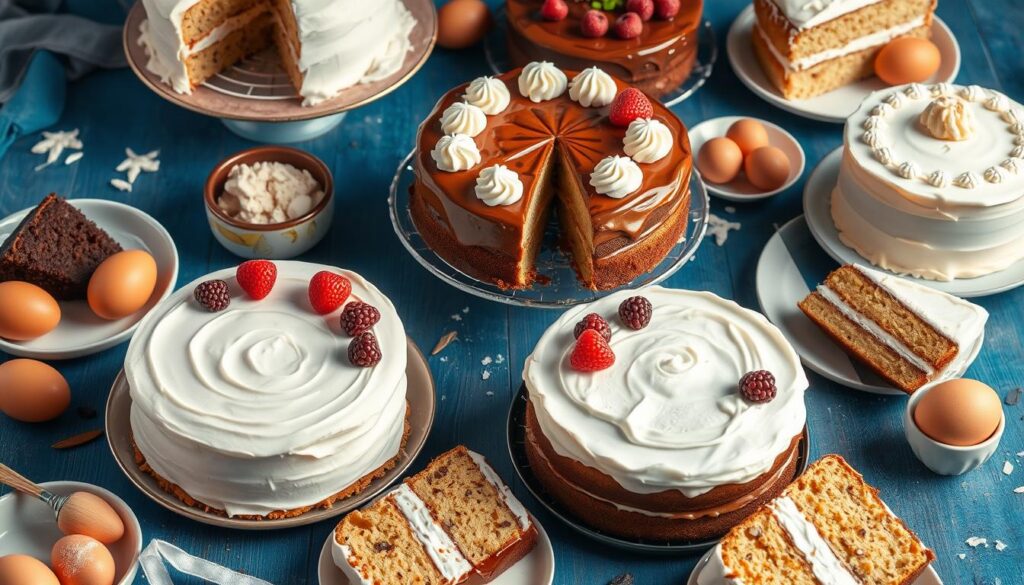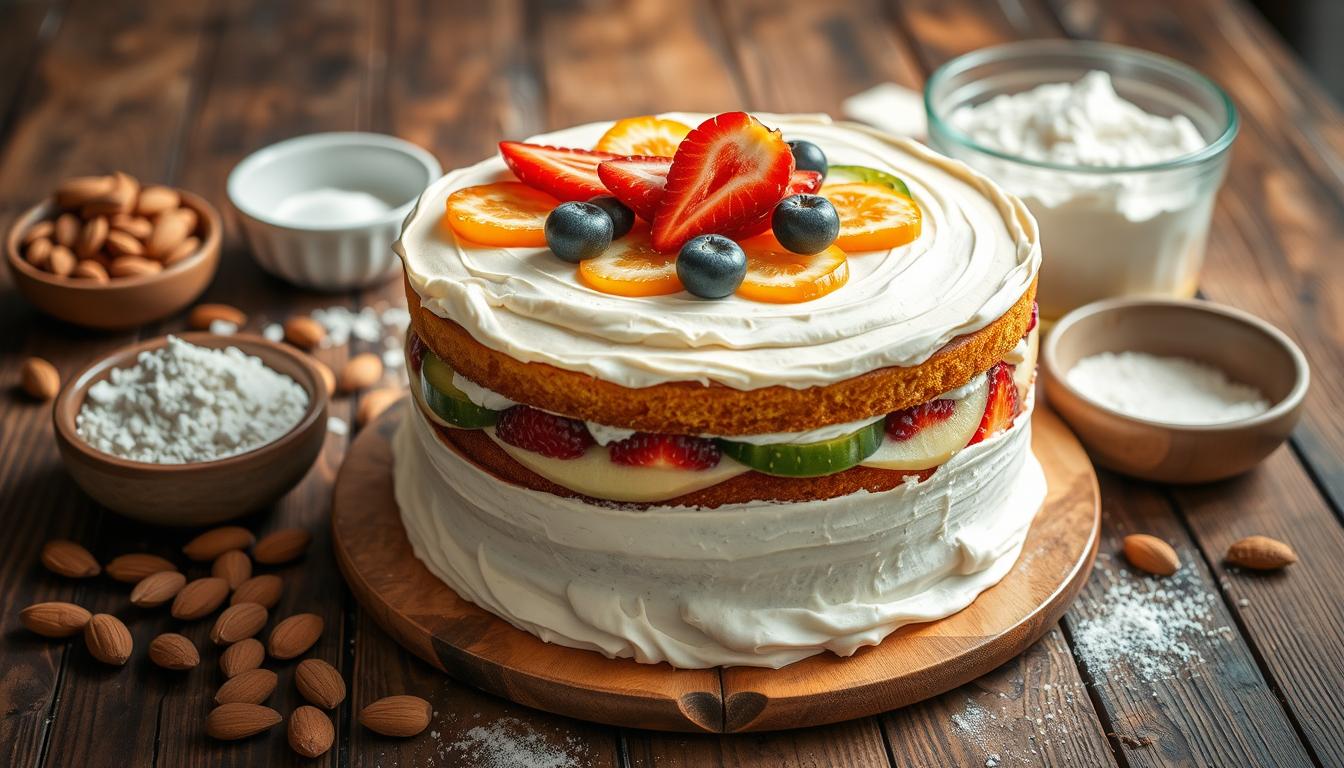Imagine walking into a room filled with the warm, inviting aroma of fresh cake. It pulls you closer, making your heart race with excitement. For many, dessert is a celebration, a moment of pure joy. But for those with gluten sensitivity or celiac disease, that joy can often be overshadowed by the fear of health repercussions.
But the world of gluten-free cake has evolved significantly. It now offers delicious options that taste amazing and let you indulge without worry.
Recent statistics show that about 25% of consumers follow a gluten-free diet for various reasons. This reflects a growing awareness of gluten intolerance and its health benefits. The gluten-free baking market is projected to reach around $15.6 billion by 2022, growing at a remarkable rate. It’s clear that gluten-free desserts are no longer just a niche market—but a vibrant, thriving segment of the culinary world.
In this article, we will explore the best gluten-free cake ideas. We’ll provide you with key ingredients, popular recipes, and tips. These will ensure your creations are not just good for you, but also delightful to taste. You deserve to indulge in dessert that is moist, flavorful, and satisfying—without compromise.
So let’s embark on this delicious journey, embracing the magic of gluten-free baking together!
Key Takeaways
- Gluten-free cakes provide a safe and delicious alternative for those with gluten sensitivities.
- Approximately 25% of consumers choose a gluten-free diet, boosting the demand for gluten-free products.
- Alternative flours, like almond flour and coconut flour, are essential for achieving the best gluten-free cake textures.
- Using natural sweeteners such as maple syrup can enhance the flavor profile of your gluten-free desserts.
- With the gluten-free market growing rapidly, there are now more resources and recipe inspirations available than ever.
Understanding Gluten and its Impact on Health
Knowing about gluten is key when picking what to eat, for those with gluten issues. Gluten is in wheat, barley, and rye, making many baked goods. But, for some, gluten can cause health problems and upset their digestion.
What is Gluten?
Gluten is a protein that makes dough elastic and chewy. It’s a big part of many baked goods. Yet, for some, gluten can be harmful, making them choose gluten-free foods.
Common Gluten-Related Disorders
Many people face health issues linked to gluten. Here are some common ones:
- Coeliac disease – Affects about 1 in 100 people worldwide and needs a strict gluten-free diet.
- Non-Coeliac Gluten Sensitivity (NCGS) – Hits around 6% of people, causing symptoms like celiac disease.
- Wheat allergies – About 1.6% of people can have severe reactions, including anaphylaxis, to wheat.
Why Choose Gluten-Free?
Some choose gluten-free for health reasons. For others, it’s because they have gluten-related disorders. Many also pick gluten-free foods for health benefits.
The gluten-free market is growing fast, expected to hit over $7.5 billion by 2026. This shows more people are looking for gluten-free options in their cooking.
| Disorder | Prevalence | Dietary Recommendation |
|---|---|---|
| Coeliac Disease | 1 in 100 individuals | Strict gluten-free diet |
| Non-Coeliac Gluten Sensitivity | Approx. 6% of population | Consider gluten-free options |
| Wheat Allergies | 1.6% of individuals | Eliminate wheat completely |
Key Ingredients for Gluten-Free Cake
Making a tasty gluten-free cake starts with knowing the key ingredients. The flour, sweeteners, and binding agents are key to the cake’s texture and taste. Let’s look at the essential parts for gluten-free baking.
Alternative Flours for Gluten-Free Baking
Choosing the right flours is key for a great gluten-free cake. Here are some top picks:
- Bob’s Red Mill Gluten-Free 1:1 Baking Flour – works well in many gluten-free recipes.
- Almond Flour – gives a nutty taste and keeps the cake moist.
- Coconut Flour – soaks up liquid, but use it sparingly to avoid dryness.
- gfJules® All Purpose Gluten Free Flour – mimics traditional cake texture.
It’s important to use the right amounts of these flours. Mixing them can create a better taste and texture.
Sweeteners That Work Best
The right sweeteners can change your cake’s flavor. Here are some good choices:
- Granulated Sugar – adds sweetness and keeps the cake moist.
- Maple Syrup – brings natural sweetness with a deep flavor.
- Coconut Sugar – has a caramel taste and is less likely to raise blood sugar.
- Swerve or Just Like Sugar – sugar substitutes that work well in baking.
Trying different sweeteners can make your recipes better and suit different tastes.
Binding Agents to Consider
Binding agents help your gluten-free cake stay moist and structured. Here are some common ones:
- Eggs – add structure and moisture; can be swapped with applesauce or flaxseed for vegan options.
- Xanthan Gum – helps gluten-free mixes feel like they have gluten.
- Cornstarch – makes your cakes lighter when used with gluten-free flour.
Each ingredient has a special role in making your gluten-free cake delicious. For the best results, be careful with your measurements and ratios.
Popular Gluten-Free Cake Recipes
Baking gluten-free cakes is fun and full of flavor. You can find recipes for everyone, from chocolate fans to those who love lighter tastes. Let’s look at some top gluten-free cake recipes that are loved by all.
Classic Gluten-Free Chocolate Cake
This chocolate cake is a hit with those who can’t eat gluten and dessert lovers. It’s made with gluten-free flour and is moist and rich. It’s easy to make, needing only 40 minutes to cook and cool. Top it with frosting for an extra special treat.
Delicious Vanilla Almond Cake
For those who like lighter flavors, this vanilla almond cake is perfect. It has a nice almond and vanilla taste. The recipe uses special flours to stay moist and gluten-free. For more details, check out this recipe.
Creative Fruit-Infused Options
Try adding fresh fruits like blueberries, raspberries, or pineapple for a unique taste. These cakes are not only tasty but also healthier. They’re becoming more popular as people want desserts with more fruit.
| Recipe | Main Flavor | Preparation Time | Cook Time |
|---|---|---|---|
| Classic Gluten-Free Chocolate Cake | Chocolate | 10 minutes | 30 minutes |
| Delicious Vanilla Almond Cake | Vanilla Almond | 10 minutes | 30 minutes |
| Fruit-Infused Cake | Seasonal Fruits | 15 minutes | 30 minutes |
These gluten-free cake recipes show how tasty and satisfying baking can be. Whether you make a classic chocolate cake or try something fruity, you’ll love every bite of your gluten-free cake.
Tips for Perfecting Your Gluten-Free Cake
Baking a moist gluten-free cake needs careful attention and some special techniques. It’s important to measure ingredients accurately. Gluten-free flours soak up moisture differently than regular flours. Knowing the right mixing methods and adjusting baking times can help you make a delicious gluten-free cake.
Measuring Ingredients Accurately
For a consistently great gluten-free cake, precision is key. Use kitchen scales to measure ingredients in grams instead of ounces. This ensures accuracy, as gluten-free flours can behave unpredictably due to their finer granule size. Remember, the weight of sugar should equal or exceed the weight of the flour to achieve the right balance of sweetness and structure.
Mixing Techniques for Texture
Mixing gluten-free batters requires a different approach. It’s beneficial to mix for at least two minutes to ensure optimal hydration. This process enhances the binding properties and helps achieve a desirable texture. During mixing, avoid over-mixing, but allow the batter to rest for 20 minutes to 1 hour. This resting period allows the ingredients to hydrate properly, which leads to a more consistent and moist gluten free cake.
Baking Times and Temperature Adjustments
When baking gluten-free cakes, you’ll find that bake times can differ by 10-15%. A close eye on the oven and regular checking for doneness can prevent undercooking. Keep in mind that gluten-free cakes often continue to set for an additional 15-20 minutes after being taken out, so allowing them to cool properly is essential for achieving the right texture.
| Key Variables | Gluten-Free Cake | Traditional Cake |
|---|---|---|
| Moisture Absorption | 1.5 to 2 times more | Standard |
| Mixing Time | 2 minutes recommended | Less than 1 minute |
| Baking Time Adjustment | 10-15% longer | Standard |
| Resting Time | 20 minutes to 1 hour | None |
Frosting and Toppings for Your Cake
Choosing the right frosting and toppings can really elevate your gluten-free cake. There are many gluten-free frosting options to choose from. You can pick from classic chocolate ganache to light cream cheese frosting. The key is to use high-quality ingredients that fit your dietary needs.
Gluten-Free Frosting Options
Here are some gluten-free frosting options to enhance your cake:
- Classic Cream Cheese Frosting: A tangy and smooth choice, perfect for most cake varieties.
- Chocolate Ganache: Made from dairy-free chocolate and coconut cream, this drizzle creates a luxurious finish.
- Vegan Vanilla Frosting: Options like Simple Mills Vanilla Frosting or Miss Jones Vanilla Frosting provide an organic and gluten-free solution.
- Peanut Butter Frosting: For a nutty flavor, combine natural creamy peanut butter with powdered sugar and almond milk.
Creative Topping Ideas
Adding toppings not only adds texture but also makes your cake look great. Here are some ideas:
- Fresh berries such as strawberries, blueberries, or raspberries offer vibrant color and natural sweetness.
- Dye-free sprinkles can make any cake festive, perfect for special occasions.
- Chocolate shavings create an elegant touch, improving both look and taste.
- Yogurt, like Siggi’s vanilla, can serve as a delightful topping, great for kids.
How to Assemble a Beautiful Cake
Assembling your gluten-free cake is where you can show off your creativity. Follow these steps for a flawless finish:
- Start by cooling your layers completely before stacking. This helps prevent sliding.
- Spread a layer of frosting on the first cake layer to adhere the next layer securely.
- Once all layers are stacked, apply a crumb coat to trap in the crumbs. Chill the cake for 30 minutes.
- Lastly, apply a generous layer of your desired frosting, finishing with toppings for enhanced beauty.
Gluten-Free Cake for Special Occasions
Making a stunning gluten-free cake for special occasions brings joy to any celebration. These cakes are perfect for birthdays, weddings, and holidays. They make your event special and meet dietary needs.
Birthday Cake Ideas
The cake is the star of any birthday. Here are some ideas:
- Chocolate Lover’s Delight: A rich chocolate gluten-free cake topped with chocolate frosting.
- Vanilla Almond Bliss: A fluffy vanilla cake infused with almond extract, perfect for those who enjoy classic flavors.
- Colorful Fruit Topping: Use berries or other seasonal fruits to create a refreshing topping, making the cake visually appealing.
Wedding Cake Inspirations
Weddings need something special. A gluten free cake delivery service can make it easy. Here are some elegant options:
- Layered Lemon Cake: Refreshing and light, this cake pairs perfectly with a cream cheese frosting.
- Red Velvet Bliss: Don’t shy away from this classic; it’s achievable in gluten-free form with a rich cream cheese glaze.
- Cakes Decorated with Edible Flowers: Incorporate seasonal flowers to match your wedding theme and delight guests with a beautiful display.
Celebrate Holidays with Style
Holidays can be festive and delicious with a gluten-free twist. Tailor your treats for occasions such as:
- Christmas: A spiced gingerbread cake, decorated with gluten-free frosting.
- Thanksgiving: A pumpkin cake that’s gluten-free can take the autumn flavors to another level.
- Fourth of July: A patriotic cake layered with strawberries and blueberries, showing your holiday spirit.

Choosing gluten-free options makes celebrations more inclusive. These ideas help create memorable gluten-free cakes. Enjoy the convenience of gluten-free cake delivery services. With thoughtful planning, every event can be a delicious feast for everyone.
| Occasion | Recommended Cake | Key Features |
|---|---|---|
| Birthday | Chocolate Lover’s Delight | Rich chocolate flavor, decadent frosting |
| Wedding | Layered Lemon Cake | Light and refreshing, elegant decoration |
| Holiday | Spiced Gingerbread Cake | Festive flavors, beautifully decorated |
Storage and Shelf Life of Gluten-Free Cake
Storing gluten-free cakes right is key to keeping their taste and texture. Knowing how to store them helps you enjoy them for longer. You’ll learn how to store leftovers, freeze your cake, and spot any spoilage signs.
Best Practices for Storing Leftovers
To keep your gluten-free cake fresh, follow these tips:
- Unfrosted cakes stay good at room temperature for 2 to 3 days. Or, refrigerate them for up to 1 week.
- Frosted cakes with buttercream can sit at room temperature for up to 2 days. Or, keep them in the fridge for up to 1 week.
- Cakes with cream cheese or mascarpone should be kept cold. They last 3 to 4 days in the fridge.
- Cakes with whipped cream or fresh fruit can last 1 to 2 days at room temperature. Or, they can stay fresh for 3 to 5 days in the fridge.
How to Freeze Gluten-Free Cake
Freezing is a great way to enjoy your gluten-free cake later. Here’s how to do it right:
- Most unfrosted cakes can be frozen for up to 1 year. Just double-wrap them in plastic wrap.
- Frosted cakes do best when frozen for up to 1 month. Chill them first for at least 30 minutes before wrapping.
- You can also freeze individual slices for months.
Signs Your Cake Has Gone Bad
To avoid eating bad gluten-free cake, watch for these signs:
- Bad smells, like from dairy-based frostings.
- Changes in texture, like being too dry or slimy.
- Visible mold or strange color changes.
Troubleshooting Common Gluten-Free Cake Issues
Baking gluten-free cakes can be tricky, but knowing common problems helps. Issues like a dense texture, crumbly cake, and dryness often come from wrong ingredient ratios and mixing. Here’s a guide to fix these gluten-free cake challenges.
Cake Too Dense? Here’s Why
A dense gluten-free cake might be from overmixing or the wrong flour blend. Gluten-free flours soak up more moisture than wheat, so you might need to adjust liquids. Reduce baking powder to avoid a rubbery feel and mix just until combined.
Patience is key. Letting the batter rest for at least 30 minutes before baking can make it lighter.
Crumbly Cake Failures: Causes and Fixes
Crumbly gluten-free cakes often lack binding agents. If your cake is crumbly, try adding an extra egg for more moisture. Xanthan gum or guar gum can help replace gluten’s binding role.
Getting the right mix of these ingredients is essential for the perfect texture.
Tips for Avoiding Dryness
Dry gluten-free cakes are a common problem. The solution is to use the right amount of fat and liquid. Adding more milk or almond milk can help keep it moist.
Don’t overbake; a few minutes less can make a big difference. Cooling the cake for at least 20 minutes after baking helps it stay moist and prevents it from becoming too dense.
For more tips on fixing gluten-free cake recipes, check out this guide. It has great advice to improve your baking and make tasty gluten-free cakes.

Resources for Gluten-Free Baking
Starting with gluten-free baking can be exciting. Having good resources is key. Look for cookbooks like “Gluten-Free Artisan Bread in Five Minutes a Day” and “The How Can It Be Gluten Free Cookbook”. They have lots of recipes and tips to help you.
Recommended Cookbooks
Online communities and blogs are also great. Sites like “Gluten-Free Girl” and forums are full of helpful tips. They let you share ideas and learn from others who love gluten-free baking.
Online Communities and Blogs
Local gluten-free stores and bakeries are also important. They have special flours and baked goods. You can try new things and find quality products without worrying about cross-contamination.

